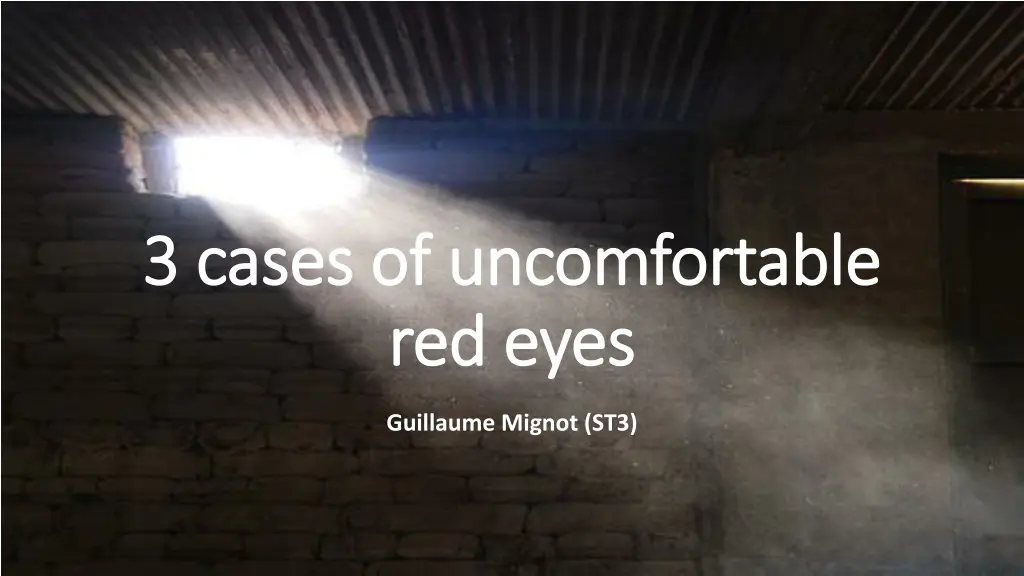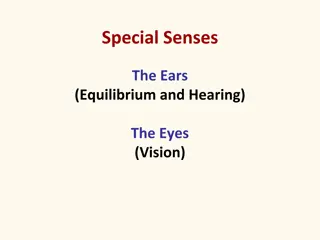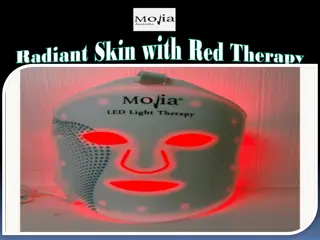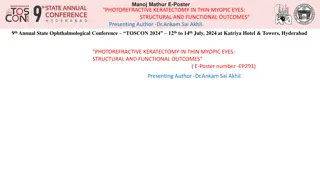
Painful Red Eye: Initial Evaluation & Management
Explore a case of a 21-year-old man presenting with increasing right eye discomfort and redness, possibly suffering from conjunctivitis, HSV keratitis, uveitis, or endophthalmitis. Learn differential diagnosis, cardinal features, questions, and management plans for each condition.
Download Presentation

Please find below an Image/Link to download the presentation.
The content on the website is provided AS IS for your information and personal use only. It may not be sold, licensed, or shared on other websites without obtaining consent from the author. If you encounter any issues during the download, it is possible that the publisher has removed the file from their server.
You are allowed to download the files provided on this website for personal or commercial use, subject to the condition that they are used lawfully. All files are the property of their respective owners.
The content on the website is provided AS IS for your information and personal use only. It may not be sold, licensed, or shared on other websites without obtaining consent from the author.
E N D
Presentation Transcript
3 cases of uncomfortable 3 cases of uncomfortable red eyes red eyes Guillaume Mignot (ST3)
Case you are an FY2 working in a GP practice 21 year old man 2 week history of increasing right eye discomfort, much worse in bright conditions Eye diffusely injected Associated with redness Vision slightly blurry, but no significant reduction in vision When he is in the dark, his right pupil seems smaller than the left
What are your initial thoughts? What are your initial thoughts? This is a case of painful red eye we will explore the most common differentials Your questions and investigations will be based on that list of differentials It is impossible to determine the diagnosis with absolute certainty without using a slit lamp (which you are not expected to do) Your initial priority is to determine the most likely diagnosis/diagnoses and decide how soon the patient needs to be seen by ophthalmology/optometry Once a diagnosis has been formally established, you may need get involved with follow up/investigations (we will find out how later)
The painful red eye Differential Cardinal features Your question Your plan Conjunctivitis Gritty, discharge, discomfort, vision clear once mucus removed ?gritty ?worse in the morning ?discharge/crust ?relatives affected ?sexual activity Watchful waiting +/- chloramphenicol +/- viral/chlamydial/gonorrhoeal swab HSV keratitis Foreign body sensation, tearing, recurrentepisodes ?previous episodes ?cold sores Refer to optometrist +/- ganciclovir if recurrent issue +/- viral swab Uveitis Photophobia, circumcilliary flush, +/- hypopyon +/- posterior synechieae systemic associations Worse with bright lights? Systematic enquiry Seek a systemic cause, refer to optometrist Endophthalmitis (focus on exogenous) Fulminant course, pain, floaters, reduced VA, redness Any recent intra-ocular surgery or injections recently? Immediate discussion with ophthalmology on call
The painful red eye Differential Cardinal features Your questions Your plan Episcleritis Localised area of scleral redness, uncomfortable Refer to optometrist Scleritis beefy red sclera, tender +++ ?pain keeping you up Systematic enquiry Seek a systemic cause, refer to optometrist/discuss with ophthalmology on call if worried about thinning/perforation Corneal ulcer Gradually increasing pain + redness +/- hypopyon Contact lens? Bell s palsy/exposure? Ulcer visible on the cornea Refer to optometrist Corneal abrasion Sudden onset, tearing +++, eye injected, blur Any trauma/blurring ?woken up from sleep Refer to optometrist Acute angle closure Acute, Severe pain, reduced vision, nausea/vomit Are pupils equal and reactive? Eye cloudy If suspected, blue light to ophthalmology
What you need to do Take a history Check visual acuity Look at the eye (you may want to use fluorescein if available) Check pupil responses Your aims are: 1) Exclude angle closure 2) Determine if the patient needs to be seen on the day or can wait (optometrists are often busy) they need to be seen on the day if you think this is a bacterial corneal ulcer
Based on your list of differentials, what is the most likely most likely diagnosis and why? You have a young patient with a history of gradual redness and discomfort (as opposed to pain). He is photophobic and his visual acuity is mildly affected. What about the anisocoria? anisocoria and ocular discomfort/pain should make you think about angle closure glaucoma (pupil block), a third nerve palsy, or Horner s syndrome here, the patient has no other features of an acute angle closure attack (by definition acute and presents classically with severe pain + reduced vision) He exhibits no motility issues/associated features to make you think this is a third nerve pasly, eye redness and photophobia would not be classical let s come back to this later
Uve-itis definition inflammation of the uvea: what is the uvea??? Iris anterior uveitis (90% of cases), the only one you really need to know about classical redness and photophobia Ciliary body intermediate uveitis, rare Choroid (vascular layer providing nourishment for the overlying retina) posterior uveitis Panuveitis all components inflamed
Examination Visual acuity (VA) 6/9 right, 6/6 left eye On the right is the picture of their eye what do you see? - Posterior synechiae i.e. adhesions between the lens and the iris due to inflammation: may eventually break or persist forever causing permanent anisocoria clue: unlike other causes of anisocoria, the pupil is usually irregular
The systematic enquiry in ophthalmology Screen for the conditions most commonly associated with ocular inflammation (spoiler most auto-immune conditions can lead to ocular issues): Seronegative spondyloarthropathies (ankylosing spondylosis, reactive arthritis, psoriatic arthritis, IBD) anterior uveitis Rheumatoid arthritis mainly scleritis not typically uveitis Lupus uveitis or scleritis Vasculitides uveitis or scleritis (GPA, Churg-Strauss, MPA, Behcet s) Sarcoidosis uveitis Infectious TB, herpetic (VZV/HSV),syphilis, HIV, Lyme disease etc For uveitis, just remember the top 4 idiopathic, seronegative, herpetic, sarcoidosis and bear in mind most autoimmune conditions can affect the eye
Questions to ask Any joint/back pain? seronegative spondyloarthropathies Any rashes? erythema nodosum, erythema migrans, psoriasis, SLE butterfly rash Any bowel/urinary issues? IBD, reactive arthritis Any mouth/anus/penile/vulval ulcers? IBD, Any cough/sinus issues? TB, sarcoidosis, GPA Any foreign travel? - TB
Systematic enquiry results The patient reports that he has been experiencing lower back pain, worse in the mornings but gets better as he starts moving for the past year - What type of pain is this? inflammatory - What is this lower back pain most likely to be? sacro-iliitis - What is your top differential? ankylosing spondylosis - What investigations do you want to request? HLAB27 - What else can you do for this patient s back pain? refer to rheumatology, prescribe NSAISs + gastro-protection - What will you do for his eye? refer to his optometrist
Case - continued He returns on Monday to the practice to get his HLAB27 taken and confesses he did not go to see his optician as you suggested as he had a weekend planned with friends He feels a lot worse What is the white wedge inferiorly? hypopyon i.e. accumulation of pus cells in the anterior chamber, sign of significant inflammation (can also be found in infections and corneal ulcers)
Treatment Most cases of anterior uveitis (intermediate/posterior need to be referred due to the high risk of sight loss and frequent need for systemic treatment) and can be treated by optometrists in the community Tapering course of topical steroids start hourly, then reduce slowly (typical regimen hourly for 24h, then 2 hourly for 48h, then 6x 4x 3x 2x 1x in 1- weekly increments Cyclopentolate 1% TDS for 1 week this is a mydriatic i.e. causes pupil dilation and a cycloplegic i.e. paralyses the ciliary body
Treatment Why use cyclopentolate? 1) By dilating the pupil, it keeps it away from the centre of the lens and prevents central posterior-synechiae 2) the ciliary is a muscle will be in spasm if inflamed, paralysing it theoretically helps with discomfort Review at 2 weeks to make sure things are improving and the patient has not developed high intra-ocular pressure secondary to steroids (common)
Clinical features of uveitis you dont need to know these as they require slit lamp skills, I have put them here for reference only as some finals question banks mention them cells i.e. clumps of inflammatory cells suspended in the aqueous, look like dust in a dark room with a ray of light flare smokiness of the aqueous keratic precipitates deposits of inflammatory cells on the corneal endothelium
Case 2 It is 17:30 The receptionist at your practice tells you he just received a call from one of your well known patients, a 42 year old myopic type 1 diabetic man getting frequent treatment from ARI. He wears glasses, no contact lenses He has been experiencing increasing right sided photophobia, redness, pain, reduced vision and floaters since 11 AM Your GP practice is very remote, the roads to Aberdeen are blocked by snow and he is the only one who can pick up his 2 young children from nursery He is looking for a quick fix
What are your thoughts? This case is really about what can wait for the next day and what can t. Very few things can t wait for the next day in ophthalmology, but some do need to be seen ASAP. The good news is that you can determine that with a very high level of certainty as a non-ophthalmologist.
What are your options? All cases of red eyes should be treated as conjunctivitis until proven otherwise? give the patient chloramphenicol and a deteriorating statement Gain more information - the referral mentions regular treatments, what kind of regular ophthalmic treatment is a diabetic likely to get? (sounds tedious and ophthalmology letters are incomprehensible anyway ) Tell the patient to call the eye clinic tomorrow when the line opens first thing in the morning? Call ophthalmology on call and use the history given by the receptionist you have a patient with a red painful eye, you don t know what it is but it is clearly an ophthalmology issue ?
You decide to find out a bit more You call the patient to determine exactly what is happening and at the same time, flick through their ophthalmology letters on Trak You find out they have been receiving intra-vitreal (into the vitreous i.e. into the eye) injections every 2 months for the past 2 years for diabetic macular oedema (12 injections so far) Their last injection was 5 days ago and went well, with no pain or complications Does this information change your management plan? What are you concerned about now?
Endo Endo- -phthalmitis phthalmitis Infection inside the eye Exogenous most common type - Occurs in 1/1000 cases of intra-ocular procedures, these include anything intra-ocular i.e. cataract surgery, intravitreal injections, retinal surgery - Occurs classically between day 2 and week 3 post-op (organisms need time to grow) - Features: pain, reduced vision, floaters, redness - Fulminant course - The only treatment is urgent intravitreal antibiotics (no other route will work)
Endophthalmitis All cases of painful red eye following intra-ocular surgery/infections should be treated as endophthalmitis until proven otherwise Note that patients often experience similar symptoms on the day of injection, however, this is almost always due to a corneal abrasion (organisms can t multiply that fast) pay attention to those presenting between day 2 and week 3
What do you need to do? Call ophthalmology on call and share your concerns DO NOT send such a patient to their optometrist for review this would cause unacceptable delay to treatment as there is nothing they can do in terms of treatment Make sure the patient is contactable he will most likely need to be blue-lighted to ARI with endophthalmitis, time is the essence
What were your other differentials? Uveitis here, the patient describes pain rather than discomfort, vision is reduced rather than blurry and the history is acute Acute angle closure this would present with severe pain and reduced vision. However, the patient would typically not by myopic but hyperopic (revisit your glaucoma lecture to find out why) Retinal detachment this is more common in myopes and the patient reports floaters, however, retinal detachments are painless and except for very rare cases, do not cause significant inflammation/redness Corneal ulcer unusual in a young patient with no predisposing factors or contact lens wear Bottom line all differentials are trumped by the recent injection
What cant wait for the next day in ophthalmology? Acute angle closure attack Orbital cellulitis (not pre-septal, the difference is crucial) Retro-bublar haemorrhage Special consideration: GCA if suspected, whether eye involving or not, the patient needs to be started on high dose steroids as soon as possible, an ophthalmic assessment can be done later and will not drastically change the management of the patient you can check if the visual acuity is affected if it is, give them 1g of IV methylprednisolone instead if practical, if you are a GP, give 60 mg of prednisolone asap (please refer to the GCA presentation, this is an essential topic). DO NOT WAIT if they had no involvement at the time of referral, you don t want them to infarct their optic nerve trying to make their way to ophthalmology! GCA is a systemic condition which can affect the eye only cases of suspected ocular involvement need to be referred to ophthalmology. Visual loss is to a large extent irreversible, steroids are used to prevent systemic complications (e.g. stroke) and protect the contralateral eye.
Other urgent conditions Penetrating eye trauma/globe rupture needs to be dealt with promptly, but realistically, surgical repair is often delayed by many hours (patients require a general anaesthesia) Ideally, severe bacterial corneal ulcers should be treated with hourly topical antibiotics as soon as possible, but a delay of a few hours is unlikely to greatly affect the outcome Retinal detachment these are NEVER repaired out of hours i.e. flashing lights, floaters and shadows can wait for the next day for assessment by an optometrist or ophthalmologist. Often, these will not be repaired for a few days, especially if the macula is affected (poorer outcome) Uveitis this can wait at least until the next day
Other conditions described as urgent Retinal detachment these are NEVER repaired out of hours i.e. flashing lights, floaters and shadows can wait for the next day for assessment by an optometrist or ophthalmologist Uveitis most cases can wait at least for the next day
Case 3 68 year old lady otherwise fit and well 7 day history of left sided scalp pain, rash over the upper left part of her face + scalp and swollen lids This morning, she noticed her right sided lids became swollen too When she prises her eye open, it is white and her vision is normal Describe the rash
Describing the rash The rash respects the midline, spares the maxillary area - What do you call such a pattern? dermatomal - What nerve is affected? the ophthalmic division of the trigeminal nerve V1 Vesicular with scabs overlying some of the ruptured vesicles + crusting Involved the tip of the nose (we will go over this later) Oedematous swelling of the eyelids What is your top differential diagnosis?
Herpes zoster ophthalmicus i.e. Shingles affecting the trigeminal nerve Herpes zoster aka varicella zoster aka chicken pox Lies dormant in the nerve s ganglion Reactivates and spreads along the nerve, especially if immunocompromised consider excluding HIV in particular
Why are both the right and left lids affected? This will often lead to queries including: has this transformed into skin cellulitis? Is zoster spreading to the contralateral nerve? This is actually very common and just represents dependent oedema, spreading to the left side due to gravity, especially when lying on the side overnight The rash of HZO only very rarely get super-infected Please refer to the presentation on orbital cellulitis VS pre-septal cellulitis, the difference is crucial
Is the eye itself affected? Please don t use expression such as swollen eye eyes can t swell the lids are swollen Lids will invariably be swollen due to oedema from the rash, the swelling may even be very pronounced Eye involvement, most often in the form of uveitis/keratitis only occurs in 50% of cases, this is more likely if the tip of the nose is involved (Hutchinson s sign) since the nerve (naso-ciliary) supplying it also supplies the eye The extent of eyelid swelling gives no indication as to the chance of the eye itself being affected
Management Open the eye prise the lids open if required If the eye is white, cornea clear and the patient is asymptomatic rom a visual point of view (acuity normal and no photophobia), eye involvement is unlikely but provided them with a deteriorating statement, especially if the tip of the nose is involved as in this case HZO with no eye involvement is effectively shingles and needs to be treated in the exact same way: oral acyclovir 800 mg 5x/day for 10-14 days Refer to community optometry after initiating systemic treatment for exclusion of eye involvement if any concerns
Key points The differential of a red eye is vast Your task as a non-ophthalmologist is to determine which cases can wait and which ones can t This can be done reliable with good history taking and a basic clinical examination (visual acuity, examination with the naked eye, pupil testing) no slit lamp required 90% of cases of uveitis are anterior i.e. iritis, top causes are idiopathic, seronegative spondylarthropathies, herpetic and sarcoid Core features: discomfort rather than pain, diffuse redness, photophobia, blurry or normal vision, gradual deterioration (significant visual loss may occur late) Ultimately, all cases will need to be seen by an optometrist or ophthalmologist at some point You may deal with potential systemic underlying conditions






















